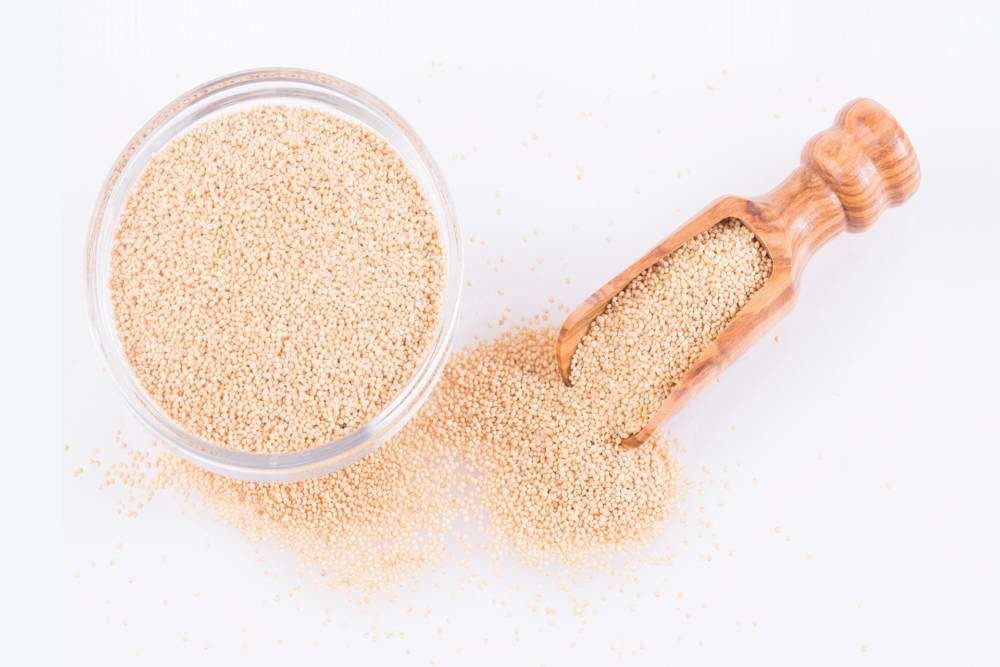With increased travel, food explorations and food coverage in the media, consumers are eagerly embracing new cuisines and ingredients, says Caroline Sluyter, Program Director of Oldways Whole Grains Council. “Many ancient grains are naturally gluten-free and the gluten-free movement has actually done a huge amount to introduce the general public to many ancient grains they hadn’t previously heard of. As more products made with gluten-free ingredients have come on the market, ancient grains like quinoa, teff, amaranth, millet and sorghum have become much more familiar to consumers, regardless of their dietary restrictions and preferences.”
It’s also easier than ever for consumers to find ancient grains, as the ingredients are being incorporated into classic favorites. “Products such as pastas, cookies, crackers and hot cereals are incorporating ancient grains more and more over the past few years,” says Bryan Reed, Grocery Buyer/Supervisor at Jimbo’s in San Diego, CA, “and while Amaranth, Millet and Kamut have long histories in our stores, Farro and Freekah have gained popularity more recently.”
As people are sampling the options, they’re liking what they get. “Consumers are often very pleased to discover that grains don’t have to be the bland, blank-slate that refined grains tend to be,” says Sluyter. “Ancient grains, and whole grains in general, can be peppery, sweet, or nutty, offering a wide variety of flavors, textures, and even colors.”
Don Trouba, Senior Director, Go-to Market – The Annex by Ardent Mills, adds that while awareness and consumption of ancient grains has been growing since the mid-2000s, there’s more education needed, especially when it comes to labels. He notes that “ancient grains bread” has far broader appeal than “einkorn bread” or “amaranth bread.” “Trendier consumers who enjoy fine dining and natural food stores are the most likely to know and understand lesser known grains such as emmer, spelt, amaranth and Khorasan wheat. The exception is quinoa, which has enjoyed early interest from chefs, foodies and restauranteurs and is versatile enough to be used as an ingredient in salads, bowls and side dishes.”
A closer look at the options
Red Fife and Khorasan “The more popular and well-known ancient grains amongst consumers are quinoa, amaranth, millet, and teff, but there are two more recently popular grains we see trending as well: red fife and Khorasan wheat,” says Stan Smith, President and Founder, Silver Hills Bakery. “All our plant-based products are made with nutrient dense organic sprouted whole grains. The sprouting process activates beneficial enzymes which cause the grains to become living, nutrient-rich food. Research shows sprouted grains have decreased levels of gluten and increased dietary fiber, more antioxidants, as well as increased folate levels, iron, manganese & calcium, and make minerals more bioavailable.” Silver Hills Bakery top sellers included The Big 16 Bread, which includes oat flakes, sunflower seeds and millet; and The Squirrelly Bread, which contains sesame seeds, sunflower seeds and raisins.Kamut International, sustainable and organic agricultural focused manufacturer of Kamut khorasan wheat, focuses on the preservation and production of their wheat under strict organic and quality standards, says Trevor Blyth, Kamut International CEO. “Kracklin’ Kamut wheat is a nutritious and delicious snack made with only three ingredients, including the ancient grain Kamut khorasan wheat, organically grown in Montana and carefully roasted in small batches at Big Sandy Organics in Big Sandy, Montana.”
Kamut khorasan wheat is a source of protein, fiber, zinc, phosphorus, magnesium, vitamin B1 (thiamin), and vitamin B3 (niacin), explains Dr. Quinn. Further, it’s high in many minerals such as selenium, copper, manganese, and molybdenum. He points to research on the effects of Kamut khorasan wheat versus modern wheat intake on people suffering from chronic ailments (cardiovascular disease, diabetes, irritable bowel syndrome and non-alcoholic fatty liver syndrome) and notes that Kamut Khorasan wheat intake brought about an increase in anti-inflammatory markers, lowering of cholesterol (especially LDL cholesterol) and lowering of blood sugar, insulin, and insulin resistance while increasing antioxidant capacity, magnesium, calcium and zinc in the blood. “These nutrients have many benefits,” says Dr. Quinn, “including contribution to normal cognitive function, normal metabolism, maintaining normal blood pressure, and protection from oxidative stress. Kamut khorasan wheat has an extremely diverse profile of polyphenols.”
Quinoa, Sorghum, Amaranth and Teff In 2017, the U.S. imported about 33.46 million kilograms of quinoa, up from 19.09 million kilograms in the previous year (2). Combining multiple ancient grains, Path of Life’s Ancient Grains & Seed Blend is a nutrient-dense combination of quinoa, brown rice, millet, buckwheat, and pumpkin seeds. Path of Life Organic Quinoa is grown at the equator 10,000 feet above sea level through work with indigenous farmers who plant the native Hunka Tuan quinoa seed which grows well in poor soil, resulting in less irrigation—which means less water, and less harm to the planet, says Audrea Fulton, VP of Sales, Path of Life.
From quinoa cookies and drinks to flour and breads, there are a lot of options to offer your customers. “Classic grain-based foods are no longer the primary applications driving innovation,” says Andrew Wheeler, VP of Corporate Marketing at FutureCeuticals. “From bars to beverages, ancient grains are being included to add value and pique shoppers’ interest. Grains deliver a formulation solution.” FutureCeuticals offers Beverage-Ready Grains—which include quinoa, oats and a protein-targeted blend. Wheeler adds, “These grains make it possible for formulators to improve the taste and texture of their protein sources and replace gums, fats, and oils with clean label hydrocolloids.”
Manufacturers who incorporate ancient grains often mix several grains together. Ardent Mills works with co-packers, private labels, manufacturers, and foodservice customers to provide gluten-free and functional mixes featuring amaranth, millet, quinoa, sorghum and teff. “There is scientific evidence and FDA-approved health claims linking diets rich in fiber-containing grain products and the reduction in chronic diseases such as heart disease and cancer,”says Trouba. “Consumers are also becoming more aware of fiber’s value in terms of gut health, satiety and sustained energy, which is a growing opportunity. Additionally, quinoa, amaranth, teff, millet and sorghum are perfect for gluten-free diets.”
One company mixing in lots of goodness: Smart Flour Foods offers gluten-free, and allergy-free ancient grain options. “The grains that we selected to include in our unique blend (sorghum, amaranth and teff) add a nutritional benefit as well, offering up a boost of fiber, protein, and calcium,” says Charlie Pace, President and CEO of Smart Flour Foods.
Fonio Terra Ingredients, a provider of bulk ingredients, offers a variety of ancient grains, including fonio, which is the topic of conversation weekly between Terra and its customers. “In addition to increased demand for plant-based protein flours, we are seeing a massive increase in customer demand of fonio, a grain from the sahel region of West Africa. Fonio has many appealing characteristics for health-conscious consumers: gluten-free, low glycemic index, strong amino acid profile, and most especially, it tastes excellent as a stand-alone side dish, within a savory recipe, or in baked goods.,” says Peter Carlson, Director at Terra Ingredients. “For Terra, the greatest benefit of fonio is its ability to make meaningful quality-of-life improvements for small-scale farmers in rural West Africa. Most of these farmers live in extreme poverty and selling at a fair price to the North American market provides a meaningful improvement in their lives and livelihoods.”
Ancient Grains for the Next Gen
Ancient grains are adding a nutrient boost to children’s foods. Hillary Graves, Founder of Little Dish, has seen how ancient grains like quinoa, millet and farro have made an impact on consumers’ choices when purchasing for their kids. “Little Dish’s Ancient Grains and Chicken meal features farro, a nutritious ancient grain that is not typically found in baby and toddler food. This recipe is very popular and offers parents an easy way to expand their child’s palate. Our products are designed for children age 12 months through toddlerhood.“We believe that today’s busy parents are looking for healthy, convenient toddler meals with high nutritional standards and that taste homemade. Moreover, our customers are looking for real-food solutions, so we are proud that each meal provides a full serving of vegetables and is made using only ingredients you’d find in your own kitchen. “Looking ahead An increase in consumers interest in ancient grains (and cutting back of empty calories) is to be expected in 2020. Watch for hemp seeds and oil incorporated into ancient grains and healthier-for-you whole-grain options as well. Silver Hills Bakery is already working on it. Smith says the company’s Hemptation Sprouted Bread is made with hemp seeds.
Going forward, retailers should expect to see more plant-based innovation merge with grain-based ingredients, adds Wheeler. “As the plant-based protein trend has evolved, consumers have begun to favor better tasting options, and grains will play a role in flavor profile and functional development. Expect to see higher demand for plant-based finished products that have a more appealing taste, texture, and look. New grain-based plant milks and yogurts, like oat, will be hot in the year ahead.”
With the environment and quality of life in mind, ancient grains offer benefits beyond nutrition. “The high cost of cheap food includes the decline of the family farm, rural America, the once vibrant communities within our big cities, the pollution of our air, water and soil by industrial ag chemicals, and most of all the decline of our health by the plague of chronic disease directly linked to our poor diets and the declining nutrition in our food,” says Dr. Quinn. “The support of regenerative organically grown ancient grains by the buying public gives everyone an opportunity to be part of the solution starting with their own health and ending up back on the farm and the soil where the food was produced in the first place. Grains are grown over a huge percentage of the land in America and if people want to have an impact on the way that land is farmed and improve their own health, they should buy and consume ancient grains organically grown in a regenerative way.” WFReferences
- https://www.researchandmarkets.com/research/d6sqdp/global_millet_and?w=12
- Shahbandeh, “Quinoa imports of the United States from 2013 to 2018,” Statista.com. Posted 8/30/19. Accessed 11.1.19. www.statista.com/statistics/486411/us-quinoa-imports.










